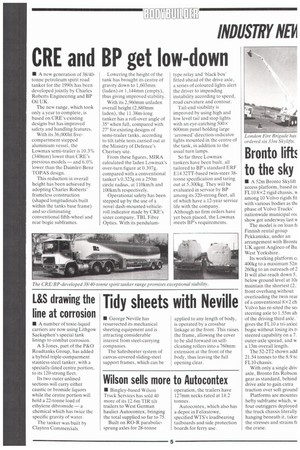CRE and BP get low-down
Page 129

If you've noticed an error in this article please click here to report it so we can fix it.
• A new generation of 38/40tonne petroleum spirit road tanker for the 1990s has been developed jointly by Charles Roberts Engineering and BP Oil UK.
The new range, which took only a year to complete, is based on CRE's existing designs but has improved safety and handling features.
With its 36,0001it fivecompartment stepped aluminium vessel, the Lowmax semi-trailer is 10.3% (340mm) lower than CRE's previous models — and 6.0% lower than the Daimler-Benz TOPAS design.
This reduction in overall height has been achieved by adopting Charles Roberts' frameless construction (shaped longitudinals built within the tanks base frame) and so eliminating conventional fifth-wheel and rear bogie subframes.
Lowering the height of the tank has brought its centre of gravity down to 1,603mm (laden) or 1,144mm (empty), thus giving improved stability.
With its 2,960mm unladen overall height (2,880mm laden), the 11.38m-long tanker has a roll-over angle of 35° when full, compared with 27 for existing designs of semi-trailer tanks, according to tilt table tests carried out at the Ministry of Defence's Chertsey site.
From these figures, MIRA calculated the laden Lowmax's over-turn figure at 0.397g. compared with a conventional tanker's 0.323g on a 250m circle radius, at 110km/h and 100km/h respectively.
Operational safety has been stepped up by the use of a novel dash-mounted vehicleroll indicator made by CRE's sister company, TBL Fibre Optics. With its pendulum type relay and 'black box' fitted ahead of the drive axle, a series of coloured lights alert the driver to impending instability according to speed, road curvature and contour.
Tail-end visibility is improved by using high and low level tail and stop lights with an eye-catching 500x 600mm panel holding large 'arrowed' direction-indicator lights mounted in the centre of the tank, in addition to the usual turn lamps.
So far three Lowmax tankers have been built, all tailored to BP's standard ERF E]4 32TT-based twin-steer 38tonne specification and taring out at 5,300kg. They will be evaluated in service by BP among its 320-strong fleet, all of which have a 12-year service life with the company. Although no firm orders have yet been placed, the Lowmax meets BP's requirements.
































































































































































































